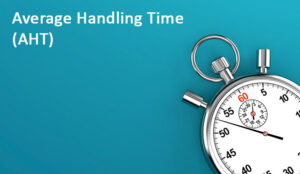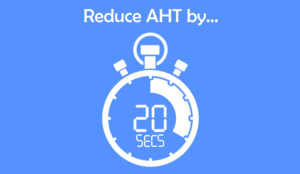Measuring Average Handling Time (AHT) is still important for many contact centres, but times vary greatly between advisors.
So, why is this?
Here are ten reasons to explain the gap in call durations between certain advisors, along with some advice on how minimise this variance without compromising quality of service.
1. Rapport-Building Ability
One of the most common reasons behind the difference in handling times between advisors is the varying levels of communication skills on the contact centre floor.
As Paul Wood, Principal Solutions Consultant at Genesys, says: “Some advisors spend more time building rapport than others. The downside of this is that AHT goes up; the trade-off is that Sales, First Contact Resolution (FCR) and Net Promoter Score (NPS) are all likely to go up.”
This positive impact on the customer experience is why most contact centres no longer target advisors on AHT.
For our advice on this topic, here are: 27 Effective Ways to Build Customer Rapport
2. Variations in Systems Knowledge/Confidence

In any organisation, some members of staff will be more tech-savvy than others, meaning that it will take different advisors varying lengths of time to go through certain processes.
As Paul Wood says, “If an advisor isn’t sure where to go or what to do next the small ums and ers can soon add up.
“Some advisors are able to multi-task better than others; navigating one system and updating notes in another, all while keeping the customer informed is a skill that is hard to teach.”
3. Some Take Ownership of a Contact, Others Don’t
In Paul Wood’s experience, “Some advisors will strive to own a problem and get the best resolution for the customer and go the extra mile or added AHT to help.”
This is because, in most contact centres, there will be advisors who do the bare minimum of what is acceptable to bring the interactions to a speedy conclusion. Others will take ownership of the customer’s query and “go the extra mile” to provide a first-class service.
While, as Paul Wood says, “this can be good for FCR and NPS, AHT will no doubt take a hit.”
For similar content, follow the link to our article: Going the Extra Mile for Customer Service
4. Overdoing ACW and Other Tricks

Naoufal El Khoumrhi, a senior operations manager, has noticed that one reason for big variations in advisor handling time is because of the impact of after-call work (ACW).
In fact, Naoufal El Khoumrhi said that some advisors play tricks to extend their handle time during ACW and that his contact centre has had to ask “the traffic manager to make sure that the advisors are not exaggerating when using that AUX.”
Yet, this is not the only trick that certain advisors will play to extend handle time, as some may also “sit on” a call in which the caller has hung up, press mute and pretend there is a fault on the line or keep the line open during a post-call IVR survey.
5. Natural Process Variation
When AHT scores vary significantly for different advisors handling the same processes, it is often because of something called “Natural Process Variation”.
Alvaro Perezalonso, a contact centre operations manager, says that this variation “is due to different reasons, such as the customer asking more questions, advisors using different scripts and so on.
“This will not change – there will always be a difference between results.
“It is important to understand that there are variables (things that are causing the high or low scores) in your process that can and need to be controlled. This will help to narrow the variation between scores.”
6. All Advisors Have Their Unique Style

While advisors will differ in their ability to build rapport and take ownership of calls, Alison Greenough, a contact centre manager, reminds us that “all advisors have their own unique style.
“Often, over a period of time, AHT figures average out through the team, but you will always have some that take longer than others to deliver excellence.
“But if you ensure advisors have freedom and autonomy where possible, you will likely find they deliver really good service.”
7. New Recruits Still Learning the Ropes
More experienced advisors are likely to have developed a style where they know which questions they should ask customers for a more efficient call, through trial and error.
However, new recruits don’t have this knowledge. This has an impact on call durations, according to Divine Gomashie, a contact centre workforce management professional.
Divine Gomashie says, “new hires take time to learn the ropes – it is very natural in all spheres of endeavour. So, in time, they will be able to adopt and learn new ways or sometimes strategy in handling their calls.”
In addition, “in the first few weeks of employment, advisors are careful to follow all quality process to the letter,” while long-term advisors are likely to have developed shortcuts.
8. Poor IT Systems

Another reason for AHT variance could be because of IT systems. Some advisors have greater skill in navigating these than others.
If systems are not easy to “work-out”, the more tech-savvy advisor will likely be quicker to complete a process that requires IT-related tasks.
Also, advisors who are quick to “type up” their call reports will have shorter ACW time than those who are slow to do so.
This means that slower typists will have a slightly longer AHT.
9. Poor Monitoring/Coaching
A lack of call quality monitoring in the contact centre can cause advisors to pick up bad habits that either extend call duration or cut it, damaging quality in the meantime.
If you let advisors loose on customers without the threat of a senior member of the team listening in, the thought of skipping some of the more tedious processes on calls may enter an advisor’s mind.
In fact, in the article “The Language of Call Centres and Why It Can ‘Offend the Ears’”, Dr. Anna Kristina Hultgren found that advisors in one contact centre were finding shortcuts to politeness on the phone. This involved simply repeating the customer’s name, instead of attempting to create genuine rapport.
So, without regular monitoring and “refresher” coaching, some advisors may pick up these disagreeable habits, causing handling times to vary greatly across the contact centre floor.
10. Luck

There is one factor that we have not yet considered, which cannot be prevented, and that is luck.
As Paul Wood says: “Some days an advisor just gets a bad batch of calls and ends up speaking to several of the Shoutalot family.”
Anyone who has worked in a contact centre will have had one of those days, which are, because of the random nature of the industry, impossible to predict.
Minimising AHT Variance
Great variance in AHT from one advisor to another can cause workforce management (WFM) related issues, making Erlang calculations less reliable.
So, how can you reduce variance in AHT without damaging quality of service?
Here are five pieces of advice.
1. Teach Advisors How to Be Direct
According to Naoufal El Khoumrhi, “some advisors are more direct than others,” and can be so without damaging the rapport-building process.
“The same information can be given using fewer words and in less time; all the advisors need is daily coaching.”
While it may be a stretch on resources to offer daily coaching, consider putting together a document that all advisors can access and offer advice on how to make customer interactions more efficient.
However, this document should be monitored to ensure customer service is not compromised.
2. Provide Online Tutorials to Navigate Systems

While some will always find it easier to get used new technologies and systems than others, providing online tutorials that advisors can refer to as they wish will help to bridge the knowledge gap.
This is because some advisors may be afraid to ask for assistance multiple times. Providing online tutorials can reassure them that the support is there to maximise their service potential and efficiency.
So, take time to create these simple videos and make them easy for advisors to view, either on their desktops and wallboards, to minimise the gap in knowledge of systems and consequently lower handle times.
For more hints for wallboard content, read our article: What Information Should You Be Displaying on Your Contact Centre Wallboards?
3. Offer Incentives
If a contact centre were to incentivise “going the extra mile”, it is likely that advisors will stay on the phone for longer, in the best interests of customers.
Offering exciting incentives to an advisor for any time they are caught doing their utmost for the benefit of customers, in quality monitoring, for example, will also improve motivation, as well as boosting service.
With each advisor encouraged to push further, this initiative could help to “even out” significant variances in call durations from one advisor to another.
Here is a list of: Staff Incentive Schemes That Work
4. Educate Yourself on Advisor Tricks

There are numerous tricks that advisors will play to extend AHT, in the hopes of not having to take on another contact soon after.
These include fiddling with the AUX, prolonging ACW and sitting on a “hanger” or transferred call, amongst others.
So, finding out how to spot these can help to bring the AHT of the few advisors who choose to use these tricks back down to a normal level.
These can be spotted through checking internet histories, monitoring and screen recording.
To find a full list of tricks and how to spot them individually, read our article: 7 Tricks That Call Centre Employees Play
5. Regularly Monitor Calls and Keep Coaching
To ensure that advisors are not handling calls in a vastly different manner that causes significant variations in AHT, monitoring mixed with feedback from a coach is the most obvious method.
Yet, according to our poll, over 40% of contact centres monitor four calls or fewer, per advisor, every month. This poll was sourced from the piece: Most Contact Centres Monitor Fewer Than Six Calls Per Agent Every Month
However, monitoring what is the equivalent to one call every week may not be regular enough. As Alison Greenough points out “by making sure advisors are regularly monitored and coached you will satisfy yourself that they are delivering as efficient a service as they can in their own unique way.”
Have we missed any other reasons for large variations in handling time between advisors?
If so, please let us know in an email to Call Centre Helper.
Author: Robyn Coppell
Reviewed by: Megan Jones
Published On: 30th Aug 2017 - Last modified: 18th Aug 2025
Read more about - Call Centre Management, Average Handling Time (AHT), Call Handling, Editor's Picks, Genesys, Management Strategies









































